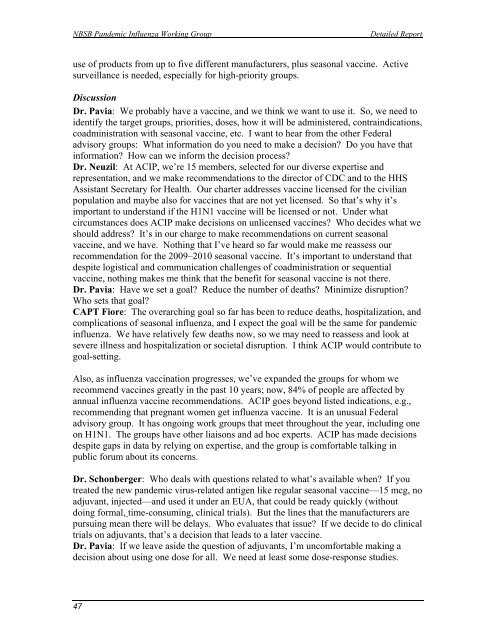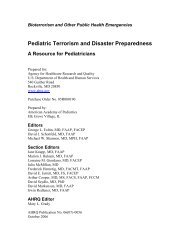H1N1 COUNTERMEASURES STRATEGY AND ... - PHE Home
H1N1 COUNTERMEASURES STRATEGY AND ... - PHE Home
H1N1 COUNTERMEASURES STRATEGY AND ... - PHE Home
Create successful ePaper yourself
Turn your PDF publications into a flip-book with our unique Google optimized e-Paper software.
NBSB Pandemic Influenza Working Group<br />
Detailed Report<br />
use of products from up to five different manufacturers, plus seasonal vaccine. Active<br />
surveillance is needed, especially for high-priority groups.<br />
Discussion<br />
Dr. Pavia: We probably have a vaccine, and we think we want to use it. So, we need to<br />
identify the target groups, priorities, doses, how it will be administered, contraindications,<br />
coadministration with seasonal vaccine, etc. I want to hear from the other Federal<br />
advisory groups: What information do you need to make a decision? Do you have that<br />
information? How can we inform the decision process?<br />
Dr. Neuzil: At ACIP, we’re 15 members, selected for our diverse expertise and<br />
representation, and we make recommendations to the director of CDC and to the HHS<br />
Assistant Secretary for Health. Our charter addresses vaccine licensed for the civilian<br />
population and maybe also for vaccines that are not yet licensed. So that’s why it’s<br />
important to understand if the <strong>H1N1</strong> vaccine will be licensed or not. Under what<br />
circumstances does ACIP make decisions on unlicensed vaccines? Who decides what we<br />
should address? It’s in our charge to make recommendations on current seasonal<br />
vaccine, and we have. Nothing that I’ve heard so far would make me reassess our<br />
recommendation for the 2009–2010 seasonal vaccine. It’s important to understand that<br />
despite logistical and communication challenges of coadministration or sequential<br />
vaccine, nothing makes me think that the benefit for seasonal vaccine is not there.<br />
Dr. Pavia: Have we set a goal? Reduce the number of deaths? Minimize disruption?<br />
Who sets that goal?<br />
CAPT Fiore: The overarching goal so far has been to reduce deaths, hospitalization, and<br />
complications of seasonal influenza, and I expect the goal will be the same for pandemic<br />
influenza. We have relatively few deaths now, so we may need to reassess and look at<br />
severe illness and hospitalization or societal disruption. I think ACIP would contribute to<br />
goal-setting.<br />
Also, as influenza vaccination progresses, we’ve expanded the groups for whom we<br />
recommend vaccines greatly in the past 10 years; now, 84% of people are affected by<br />
annual influenza vaccine recommendations. ACIP goes beyond listed indications, e.g.,<br />
recommending that pregnant women get influenza vaccine. It is an unusual Federal<br />
advisory group. It has ongoing work groups that meet throughout the year, including one<br />
on <strong>H1N1</strong>. The groups have other liaisons and ad hoc experts. ACIP has made decisions<br />
despite gaps in data by relying on expertise, and the group is comfortable talking in<br />
public forum about its concerns.<br />
Dr. Schonberger: Who deals with questions related to what’s available when? If you<br />
treated the new pandemic virus-related antigen like regular seasonal vaccine—15 mcg, no<br />
adjuvant, injected—and used it under an EUA, that could be ready quickly (without<br />
doing formal, time-consuming, clinical trials). But the lines that the manufacturers are<br />
pursuing mean there will be delays. Who evaluates that issue? If we decide to do clinical<br />
trials on adjuvants, that’s a decision that leads to a later vaccine.<br />
Dr. Pavia: If we leave aside the question of adjuvants, I’m uncomfortable making a<br />
decision about using one dose for all. We need at least some dose-response studies.<br />
47
















